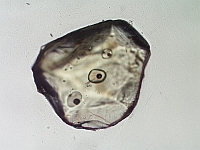Australian scientists have helped resolve a geological controversy surrounding a rare type of ancient volcanic rock. The findings have led to valuable new insights into the Earth's early geological processes.
Professors Hugh O'Neill (Australian National University) and Leonid Danyushevsky (ARC Centre of Excellence in Ore Deposits, University of Tasmania) worked with UK and US researchers to develop a powerful new synchrotron technique. Called 'iron K-edge x-ray absorption near-edge structure spectroscopy', the technique provides highly detailed information about the chemistry of samples just a fraction of a millimetre across.
The researchers used the technique to study 2.7 billion-year-old samples of an ancient type of volcanic lava called komatiite from Zimbabwe. Komatiite's unusual chemical composition means it must have formed from much higher degrees of melting of the Earth's mantle than modern lavas. Until the new synchrotron studies, however, it was unclear whether the higher degree of melting happened at temperatures up to 500 degrees hotter than the present mantle ('hot-melting'), or at less extreme temperatures in the presence of water ('wet-melting').
 |
Olivine grain (0.35 mm diameter) from Belingwe komatiite with melt inclusions (Photo: Leonid Danyushevsky) |
Using a beamline at the Advanced Photon Source (APS) in Chicago, the team focussed on tiny drops of komatiite volcanic glass trapped inside crystals. The glasses are cooled samples of the original lava, which may have been protected from weathering for billions of years by their enclosing crystals. The team used the synchrotron to show that the glass had not oxidised during this long period of time, indicating that the small amount of water in the glass was probably all there was when the rocks originally formed. The researchers concluded that the hot-melting theory was correct, implying that the Earth's mantle was much hotter billions of years ago than it is now, which helps explain why some valuable kinds of mineral deposits are only found in ancient rocks. The work was published in Nature in October 2008.
Hugh is off to the APS again in March 2009 to apply the same method to other glass inclusions from Leonid's extensive collection. The water contents in these inclusions were analysed by Leonid on the Australian Synchrotron's infrared beamline in October 2008. The team hopes to show that their x-ray method can be used to measure the extent of oxidation of any type of volcanic glass. Because the method only requires tiny amounts of glass, it can be used on rare samples (like the komatiite glass drops) that could not previously be analysed by other methods. Knowing the oxidation state of a volcanic glass will be a great help to geologists engaged in the hunt for mineral deposits associated with ancient volcanoes.
The team is looking forward to using new x-ray beamline facilities now available at the Australian Synchrotron to apply their method to Australian rocks.
